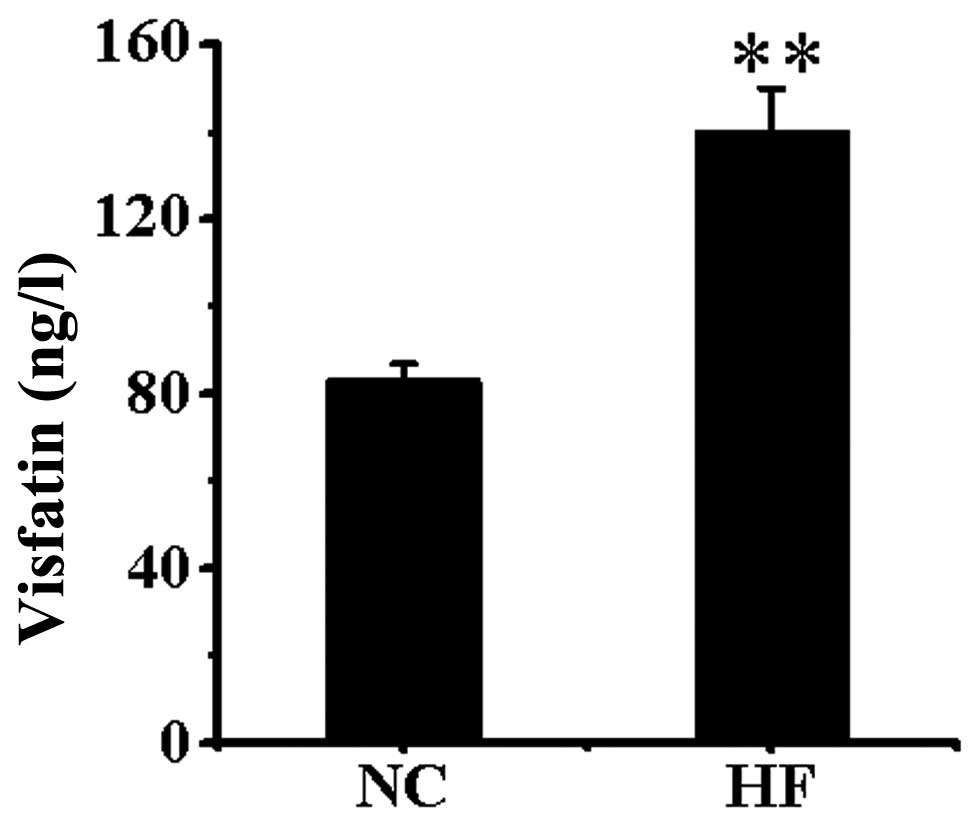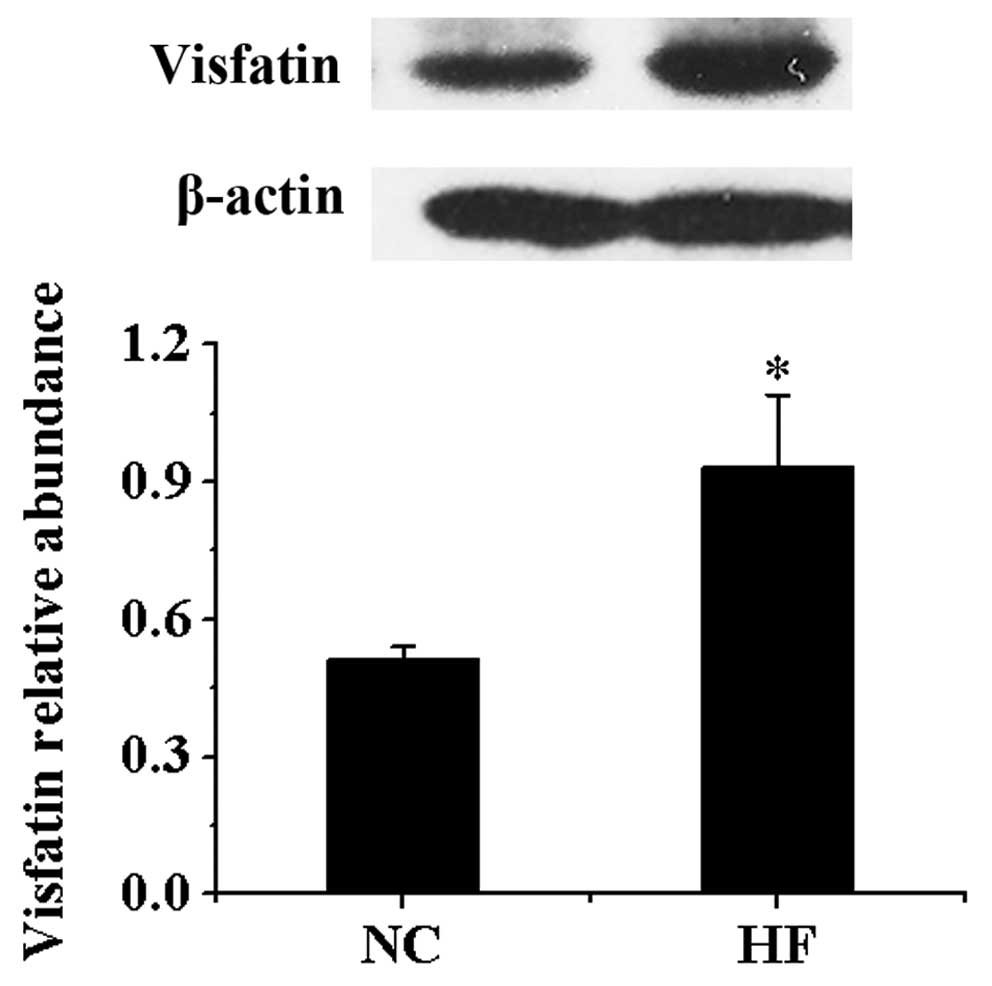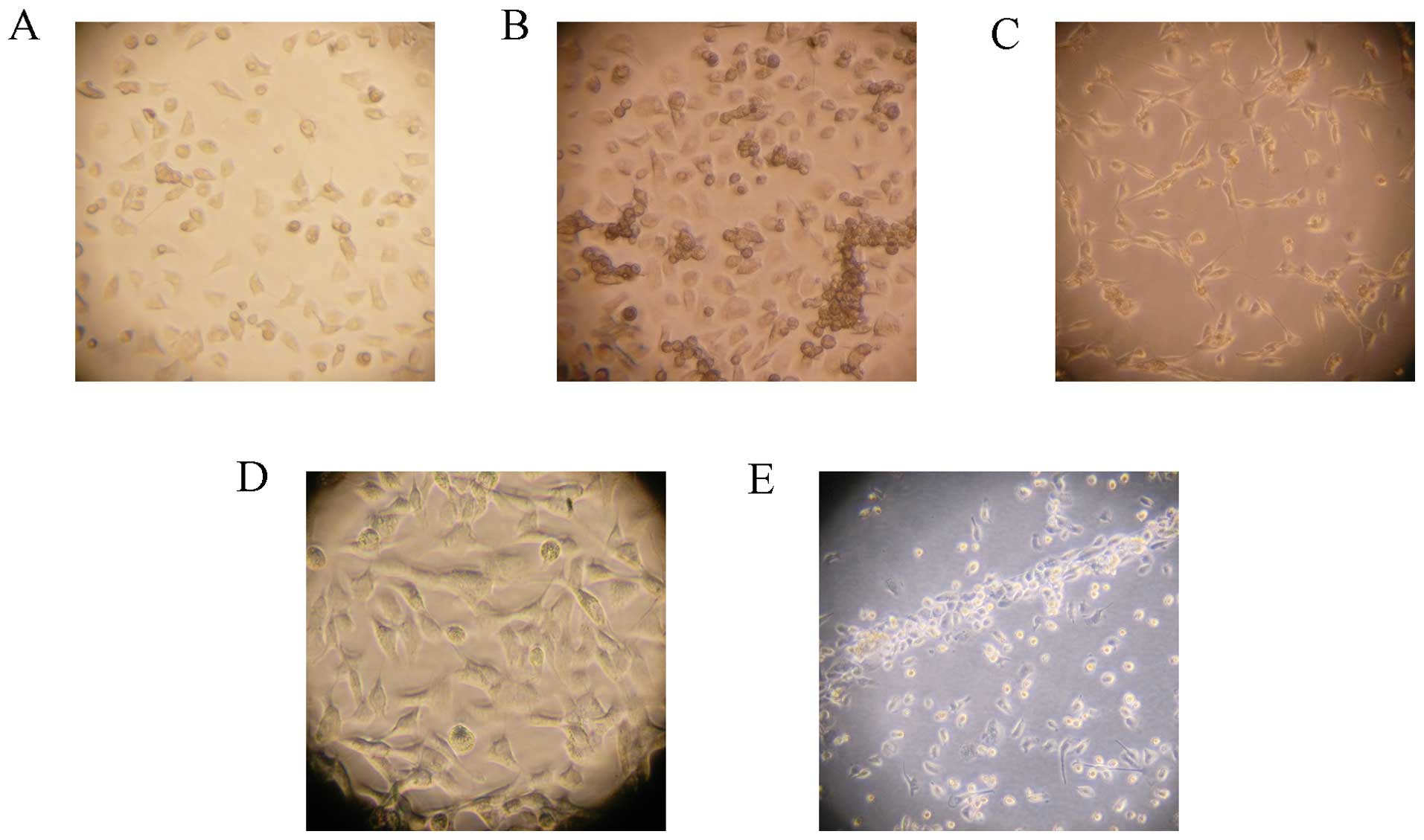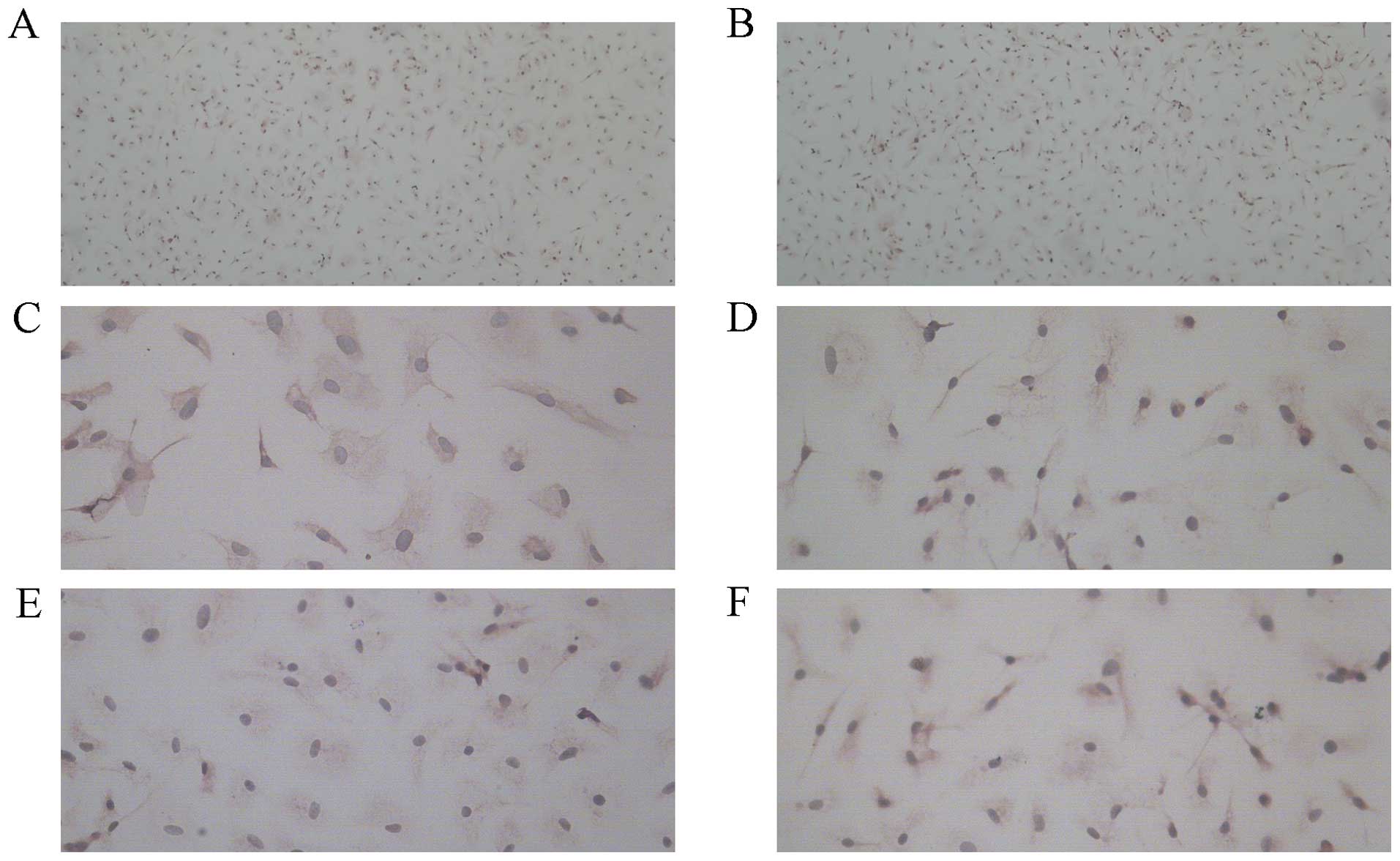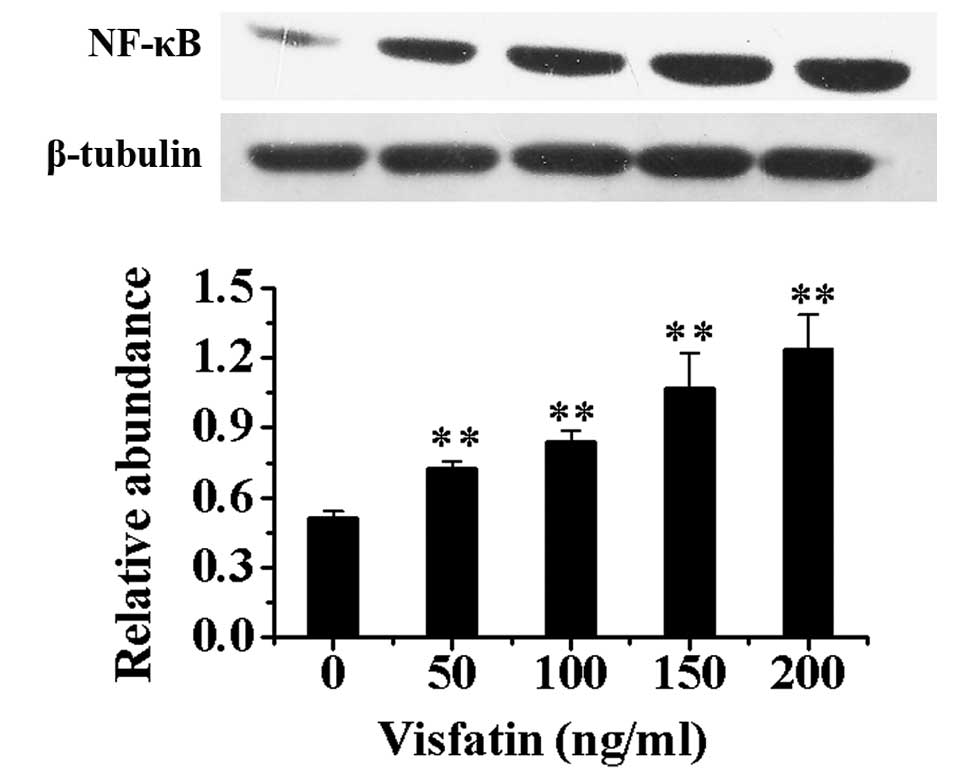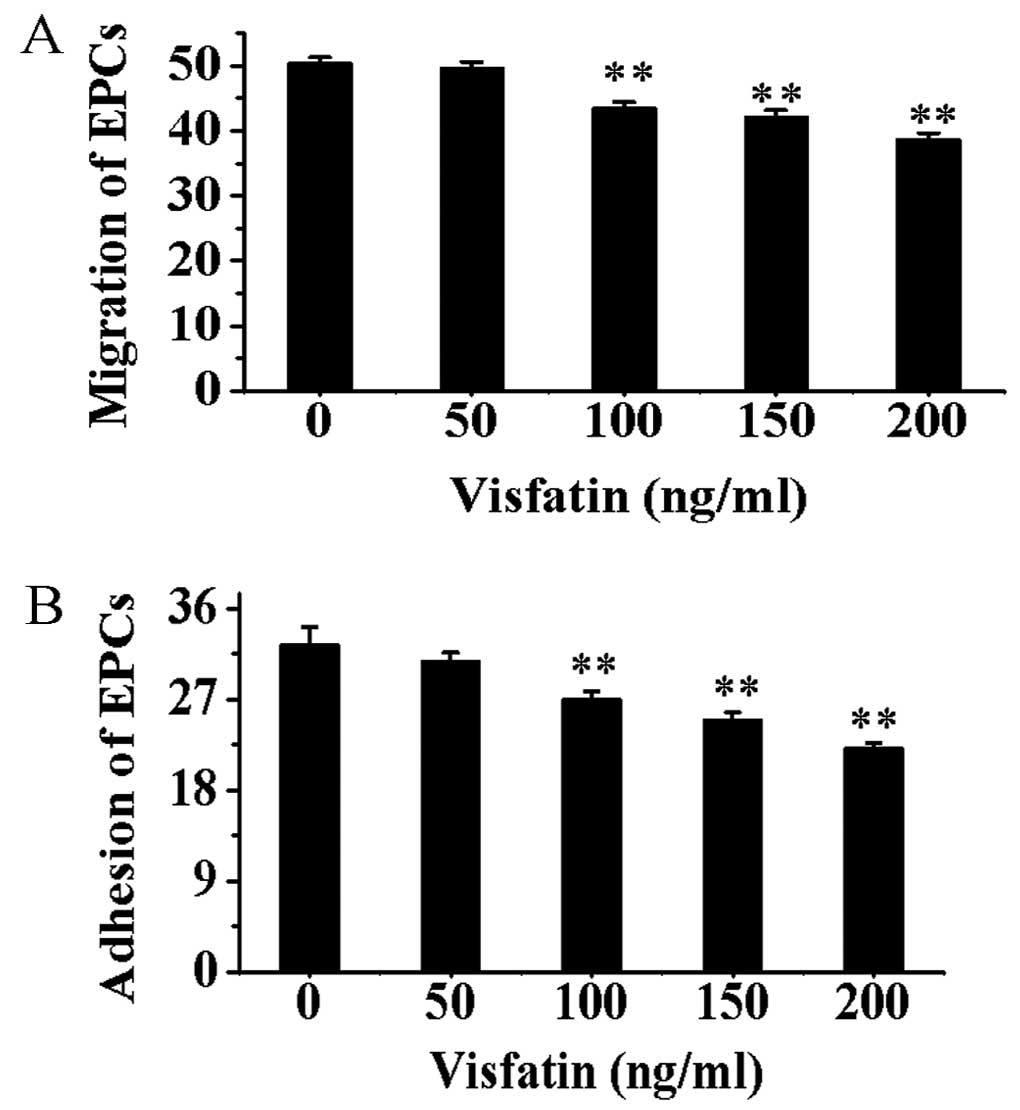Effect of visfatin on the function of endothelial progenitor cells in high-fat-fed obese rats and investigation of its mechanism of action
- Authors:
- Published online on: June 14, 2012 https://doi.org/10.3892/ijmm.2012.1032
- Pages: 622-628
Abstract
Introduction
With the change of life style and diet structure, obesity has become increasingly prevalent all over the world. The incidence of obesity is attributable to many interrelated factors, of which high-calorie intake, high-fat diet and lack of physical activity are important risk factors. Excess energy is stored as fat and leads to obesity. Moreover, obesity is closely associated with the development of many diseases, including hypertension, type 2 diabetes, metabolic syndrome, dyslipidemia. The excessive accumulation of visceral adipose tissue, especially the accumulation of abdominal adipose tissue is an important risk factor of cardiovascular disease.
Endothelial progenitor cells (EPCs) originate from bone marrow and are progenitor cells which have the capacity to migrate to the peripheral circulation and to differentiate into mature endothelial cells. Under the circumstances of vessel impairment and tissue ischemia, the EPCs in the bone marrow can be mobilized into the blood circulation and settle in impaired and ischemic locations. EPCs are then differentiated into mature endothelial cells and participate in angiogenesis and re-endothelialization. Therefore, EPCs play an important role in maintaining the integrity of endothelial structures and the function of vascular endothelium. EPCs are influenced by many factors, such as physical activity and smoking (1,2). Many diseases can cause the decrease in the quantity of EPCs. EPCs in diabetic patients decrease significantly in quantity with an impaired restoration capacity of vessels (3–5). Hyperglycemia, hyperinsulinemia and hyperlipidemia can all lead to the impairment of EPCs.
Overweight and obesity are closely related to the incidence and mortality of cardiovascular diseases. According to the studies, dysfunction of vascular endothelium exists in overweight and obese populations. Because endothelial damage and dysfunction are considered to be a major underlying mechanism for cardiovascular disease, the prompt endothelial repair/regeneration is very meaningful in maintaining a normal endothelium function and preventing cardiovascular events (6–9). Recent studies indicate that the function of circulating EPCs is impaired in obese individuals. However, the underlying mechanism remains unclear.
Adipose tissue can secrete many different adipokines. Studies indicate that abdominal obesity can change the levels of many adipokines (10–15). Visfatin is an adiponectin discovered in 2005. The effect of visfatin on the vascular inflammation in obesity and type 2 diabetes draws more and more attention. Visfatin possesses many biological functions. The function of visfatin is intimately correlated with glucose and lipid metabolism and can be considered a new proinflammatory factor which modulates the inflammatory processes of atherosclerosis (16–21). Research shows that there is an increased visfatin level in diabetic and obese patients (22,23), which is related to vascular dysfunction (24).
Transcriptional factor nuclear factor-κB (NF-κB) is a key inflammatory mediator, which can modulate the expression of a series of factors in the inflammatory processes. It is found that visfatin can upregulate the expression of NF-κB in human endothelium in umbilical veins, and lead to endothelial inflammation (17,25). Based on these findings, we hypothesized that visfatin is an upstream influential factor leading to the decrease of EPCs in obese individuals by upregulating NF-κB in EPCs. Upregulated NF-κB induce inflammation and apoptosis of EPCs and results in decreased quantities of EPCs. At present, the relation of visfatin to EPCs is less investigated.
In the current study, we measured the quantity of EPCs, serum visfatin and expression of visfatin in visceral adipose tissue in high-fat-fed obese rats. The correlations of the above indices were analyzed. To observe the effect of visfatin on EPCs and to study the possible underlying mechanism, cultured primary EPCs were incubated with different concentrations of visfatin. The migration and adhesion ability and the protein expression of NF-κB in nuclei of EPCs were detected. We hope the present study can provide a potential new target for intervening with and preventing the development of vascular diseases in obese individuals.
Materials and methods
Animals
Male Wistar rats, 200–250 g of weight, were obtained from Hebei Medical University Animal Laboratory. Rats were randomly divided into two groups: normal control group (NC, n=11) and high-fat-fed group (HF, n=11). The animals were kept in a temperature-controlled room (22±1°C) on a 12-h light/dark cycle with free access to food and water. The NC group animals were fed a standard lab diet (65.5% calories from carbohydrate, 10.3% calories from fat, and 22.4% calories from protein; 384 kcal/100 g). The HF group rats were fed a high-fat diet (20% calories from carbohydrate, 60% calories from fat, and 20% calories from protein; 502 kcal/100 g; Research Diets, Inc., USA). After a 16-week feeding, the Lee’s index and body weight were measured. Lee’s index = body weight(g)1/3 × 1,000/body length(cm). Animal studies and relative protocols were approved by the Animal Care and Use Committee at the Hebei Medical University.
Measurement of serum insulin and visfatin
Serum insulin and visfatin were detected by ELISA (sensitivity, 0.01 ng/ml and 1 ng/ml, respectively) with an ALISEI microplate reader (Seac Srl, Italy).
Immunoblotting
Adipose tissue samples were homogenized in ice-cold lysis buffer (50 mM Tris pH 7.5, 150 mM NaCl, 1% Triton X-100, 10 mM NaP, 100 mM NaF, 2 mM Na orthovanadate, 1 mM EDTA, 1 mM EGTA, 10% glycerol), supplemented with protease inhibitor cocktail tablets (Roche) and DL-dithiothreitol and solubilized for 30 min at 4°C. Protein samples were then denatured in SDS sample buffer (125 mmol/l Tris-HCl, pH 6.8, 50% glycerol, 2% SDS, 5% β-mercaptoethanol, and 0.01% bromophenol blue). Equal amounts of tissue lysates (60 μg protein) were resolved by SDS-PAGE and immunoblotted with appropriate antibodies against visfatin (Biovision). Immunolabeled bands were quantitated by densitometry. To determine the protein contents of NF-κB in nuclei in EPCs, nuclear protein was extracted from cultured EPCs using a nuclear protein extraction kit (Applygen Technologies). Tissue lysates (60 μg protein) were resolved by SDS-PAGE and immunoblotted with appropriate antibodies against NF-κB (Santa Cruz Biotechnology, Inc.). Immunolabeled bands were quantitated by densitometry. β-tubulin (Abcam) was used as an internal standard.
Culture of EPCs
Hollow bones of rat legs were prepared by standard surgical procedures, and whole bone marrow was harvested by flushing marrow with 500 μl PBS using a syringe with a 20-gauge needle. Briefly, rat bone marrow mononuclear cells (MNCs) were isolated from flushing liquid by Ficoll density centrifugation. Cells were centrifuged for 30 min at room temperature (1,000 rpm) for 10 min. MNCs were isolated and washed with PBS. MNCs were resuspended in EGM-2MV medium (Lonza). Six-well or 24-well tissue culture plates precoated with fibronectin (Solarbio, China) were seeded at a density of 2x106/ml and cultured in a humidified incubator. After 48 h of culture, adherent cells were washed with EGM-2MV, and EGM-2MV medium was added to each well. The medium was changed daily for 7 days and then every other day until the first passage. Cells were observed daily under inverted microscopy.
Determination of EPCs numbers and cellular characterization
Immunocytochemistry was performed in cultured cells to detect the expression of CD34 and kinase insert domain receptor (KDR). CD34 and KDR also termed Flk-1 are surface markers of EPCs. Briefly, EPCs were fixed in 4% paraformaldehyde in PBS for 20 min, washed 3 times with PBS, and respectively stained with various EPCs specific markers: rabbit anti-rat CD34, mouse anti-rat KDR (Boster, China). The cells were incubated with secondary antibodies (either anti-mouse or anti-rabbit) and then in third antibody. Cells were colored with DAB and stained with hematoxylin.
Moreover, EPCs were characterized by cellular uptake of DiI-labeled acetylated LDL (DiI-acLDL; Molecular Probes, Eugene, OR, USA) and binding of fluorescein isothiocyanate-conjugated lectin from Ulex europaeus agglutinin (FITC-Lectin-UEA-1; Sigma). Briefly, after 10-day culture, Dil-acLDL (2.5 μg/ml) were added on cells for 4 h and washed for 3 times. After fixing in 2% paraformaldehyde for 20 min, FITC-Lectin-UEA-1 (10 μg/ml) were added and cultured for 1 h. The cells were then observed under laser scanning confocal microscopy. Orange double-stained cells positive for both DiI-acLDL and FITC-Lectin-UEA-1 were identified as EPCs. EPCs were counted under laser scanning confocal microscopy.
Treatment of EPCs by visfatin incubation
Bone marrow MNCs from male Wistar rats fed a standard diet were isolated and cultured as described. EPCs were determined from MNCs and treated with visfatin at different concentrations (0, 50, 100, 150, 200 ng/ml) for 48 h.
Evaluation of the migration capacity of EPCs
Single cell suspension were planted in 24-well plate as a density of 5×104/ml. After 24-h culture, cells were digested with 0.25% trypsin solution and counted. Culture medium were added into the lower chamber of a modified Boyden chamber; 2×104/ml of EPCs were suspended in 150 μl of medium and added into the upper chamber. After 24 h of culture, the unmoved cells were scratched from the filtration membrane. The migrated cells were fixed with formalin and stained with hematoxylin. Ten fields were randomly chosen to count the migrated cells under inverted microscopy (x400).
Evaluation of adhesion capacity of EPCs
Single cell suspensions were plated in 24-well plates at a density of 5×104/ml. After 24-h culture, cells were digested with 0.25% trypsin solution. Equal numbers of cells were plated into 96-well plate and incubated for 30 min at 37°C. Unattached cells were washed out. Ten fields were randomly chosen to count the attached cells under inverted microscopy (x400).
Statistical analyses
Data are presented as means ± SE. The data were tested by homogeneity test for variance. The t-test was used for comparison of normally distributed data with homogenous variance. The rank sum test was used for comparison of normally distributed data with heterogenous variance. One-way analysis of variance was used for comparison of normally distributed data with homogeneous variance relevant groups. Linear regression was used to detect a correlation. Differences at P<0.05 were considered to be statistically significant.
Results
Comparison of baseline characteristics between NC and HF groups
Lee’s index, body weight (BW), visceral adipose tissue (VAT), fasting blood glucose (FBG), fasting insulin in serum (FINS), homeostasis model assessment-insulin resistance (HOMA-IR), plasma triglyceride (TG), plasma total cholesterol (TC) were all significantly higher in the HF group than in the NC group (Table I).
Visfatin level in serum
Serum visfatin was significantly higher in the HF group than in the NC group (P<0.01) (Fig. 1).
Protein expression of visfatin in VAT
Compared with NC group, the protein contents of visfatin in VAT in HF group were significantly higher compared with the NC group (P<0.05) (Fig. 2).
Culture of EPCs
Newly isolated bone marrow mononuclear cells were round, transparent and suspended in medium. After 48 h of plating, part of the cells attached. The adherent cells gradually enlarged and stretched. After 4–7 days of plating adherent cells grew as colonies. Cells were round, triangle, oval or irregular. After 10 days, cell were linearly arranged (Fig. 3).
Determination of EPCs numbers and cellular characterization
EPCs were analyzed by immunohistochemical staining under a microscope. CD34 and KDR are surface markers of EPCs (Fig. 4).
After a 10-day culture, by uptake of DIL-Ac-LDL and binding of FITC-Lectin-UEA-1, EPCs which were double-stained cells as yellow were observed and counted under laser scanning confocal microscopy. The numbers of EPCs were significantly lower in the HF group compared with those in the NC group (P<0.01) (Table II) (Fig. 5).
Correlation analysis of different index
The Pearson correlation analysis indicated that the numbers of EPCs were negatively correlated with serum visfatin (r=−0.886, P<0.01), CRP (r=−0.849, P<0.01), FBG (r=−0.753, P<0.01), HOMA-IR (r=−0.775, P<0.01), TC (r=−0.744, P<0.01), TG (r=−0.821, P<0.01), VAT (r=−0.631, P<0.01) and BW (r=−0.656, P<0.01).
Effect of visfatin treatment on EPCs
Compared with EPCs without incubation of visfatin, the protein expression of NF-κB in nuclei in EPCs after treatment with different concentrations of visfatin increased in a dose-dependent manner (P<0.01) (Fig. 6).
Compared with EPCs without incubation of visfatin, the migration and adhesion capacities of EPCs treated with visfatin were gradually decreased in a dose-depent manner (P<0.01) (Fig. 7).
Discussion
Obesity has become increasingly prevalent and is an important risk factor of cardiovascular disease (26–29). Studies indicate that obesity, similarly to other risk factors including diabetes mellitus, hypertension and smoking, can impair the function of the vascular endothelium (30–33) and lead to arteriosclerosis and other cardiovascular diseases (6–9). Endothelial progenitor cells (EPCs) play an important role in maintaining the complement of endothelial structure and normal function of the vascular endothelium. EPCs originate from the bone marrow. EPCs released into the blood circulation after stimulation can differentiate into mature endothelial cells and especially settle in ischemic locations and participate in the re-endothelialization of injured blood vessels. According to previous studies, the alterations in EPCs exist in overweight and obese individuals. Several recent studies show that the numbers of EPCs decreased in overweight and obese populations with an impaired proliferation capacity (34–39). Heida et al (34) found that the numbers of EPCs in the blood circulation decreased in obese individuals and obese mice; meanwhile, the migration and adhesion capacity of EPCs were impaired. MacEneaney et al (35) also found an decrease in EPCs quantity in overweight and obese individuals with an weakened proliferation capacity. However, the underlying mechanism by which the quantity and function of EPCs are impaired remain unclear.
Visfatin is an adipokine which is secreted by adipose tissue. The effects of visfatin include promoting the differentiation of adipose cells and the synthesis and storage of adipose tissue, promoting inflammation of vascular endothelial cells and leading to the development of arteriosclerosis (16,40–43). By far, the possible relationship of visfatin to EPCs is less investigated. We hypothesized that visfatin might be involved in the impairment of EPCs function in the situation of obesity. In the present study, we fed the rats with a high-fat diet for 16 weeks and induced obesity in rats along with the development of whole body insulin resistance (as shown by increased FBG, FINS and HOMA-IR). EPCs were significantly decreased in rats in HF group, which is consistent with previous studies. Meanwhile, serum visfatin and the protein contents of visfatin were significantly increased by high fat feeding. Correlation analysis indicated that the quantity of EPCs are negatively correlated with visfatin levels, indicating a possible relationship of visfatin to EPCs and that visfatin is possibly an influential factor of the quantity of EPCs.
A possible underlying mechanism of the influence of visfatin on EPCs quantity might be the inflammatory effect of visfatin. Previous studies found that visfatin induces the upregulation of inflammatory factors and adhesion molecules in human umbilical vein endothelial cells (HUVECs) through the NF-κB pathway (17,20,21,25). Lee et al (17) found that the activity of NF-κB was increased in HUVECs after incubation with visfatin, with the upregulation of IL-6, IL-8, ICAM-1, VCAM-1 and E-selectin genes. The activity of NF-κB increased in both HUVECs and epithelial tumor cells when incubated with visfatin for 24 h; the activity increased with the treatment of visfatin in a dose-dependent manner (25). Furthermore, visfatin can increase the expression of NF-κB, tumor necrosis factor-α (TNF-α), matrix metalloproteinase-9 (MMP-9), interleukin-8 (IL-8), IL-6 in monocytes by activating insulin receptor (IR)-Ras-MAPK signaling pathway and the insulin-independent p38 pathway (16). Based on these findings, we presume that visfatin might influence the function of EPCs through the NF-κB pathway.
In our study, we incubated the EPCs with different concentrations of visfatin to observe the effect of visfatin on the expression of NF-κB in nuclei of EPCs. The concentration of visfatin was based on serum visfatin levels measured in the animal study. The results show that the expression of NF-κB in nuclear EPCs were significantly increased by visfatin treatment in a dose-dependent manner, which is consistent with the previous study that visfatin possesses inflammatory effects. The effect of visfatin on NF-κB in EPCs support our hypothesis that visfatin may have an effect on EPCs through the NF-κB pathway. Meanwhile, the capacity of EPCs to migrate and adhere was impaired by visfatin treatment. The possible mechanism is that inflammation induced by visfatin causes the upregulation of a series of inflammatory factors including NF-κB and TNF-α, leading to the aging and apoptosis of EPCs and resulting in decreased quantities and impaired functions of EPCs (44–46). Further investigation is warranted.
In summary, serum visfatin and protein contents of visfatin in VAT increased in obese rats fed a high-fat diet, accompanied with decreased quantities of bone-marrow originating EPCs. Visfatin may be involved in the development of decreased EPC numbers and impaired functions through the NF-κB pathway. The present study provides a new target for prevention of the development of cardiovascular disease in obese populations.
Acknowledgements
We thank Mr. Chao Wang for continuous advice, support and technical assistance.
Abbreviations:
|
EPCs |
endothelial progenitor cells; |
|
VAT |
visceral adipose tissue; |
|
NF-κB |
nuclear factor-κB; |
|
MNCs |
marrow mononuclear cells; |
|
EGM-2MV |
endothelial growth media-2MV; |
|
KDR |
kinase insert domain receptor; |
|
Flk-1 |
fetal liver kinase-1; |
|
DAB |
diaminobenzidine; |
|
DiI-acLDL |
DiI-labeled acetylated LDL; |
|
FITCLectin-UEA-1 |
fluorescein isothiocyanate-conjugated lectin from Ulex europaeus agglutinin; |
|
BW |
body weight; |
|
FBG |
fasting blood glucose; |
|
FINS |
fasting insulin in serum; |
|
TG |
triglyceride; |
|
TC |
total cholesterol; |
|
ICAM-1 |
intercellular adhesion molecule 1; |
|
VCAM-1 |
vascular cell adhesion molecule 1; |
|
TNF-α |
tumor necrosis factor-α; |
|
MMP-9 |
matrix metalloproteinase-9; |
|
IL-8 |
interleukin-8; |
|
IR |
insulin receptor; |
|
Ras-MAPK |
Ras-mitogen-activated protein kinases |



